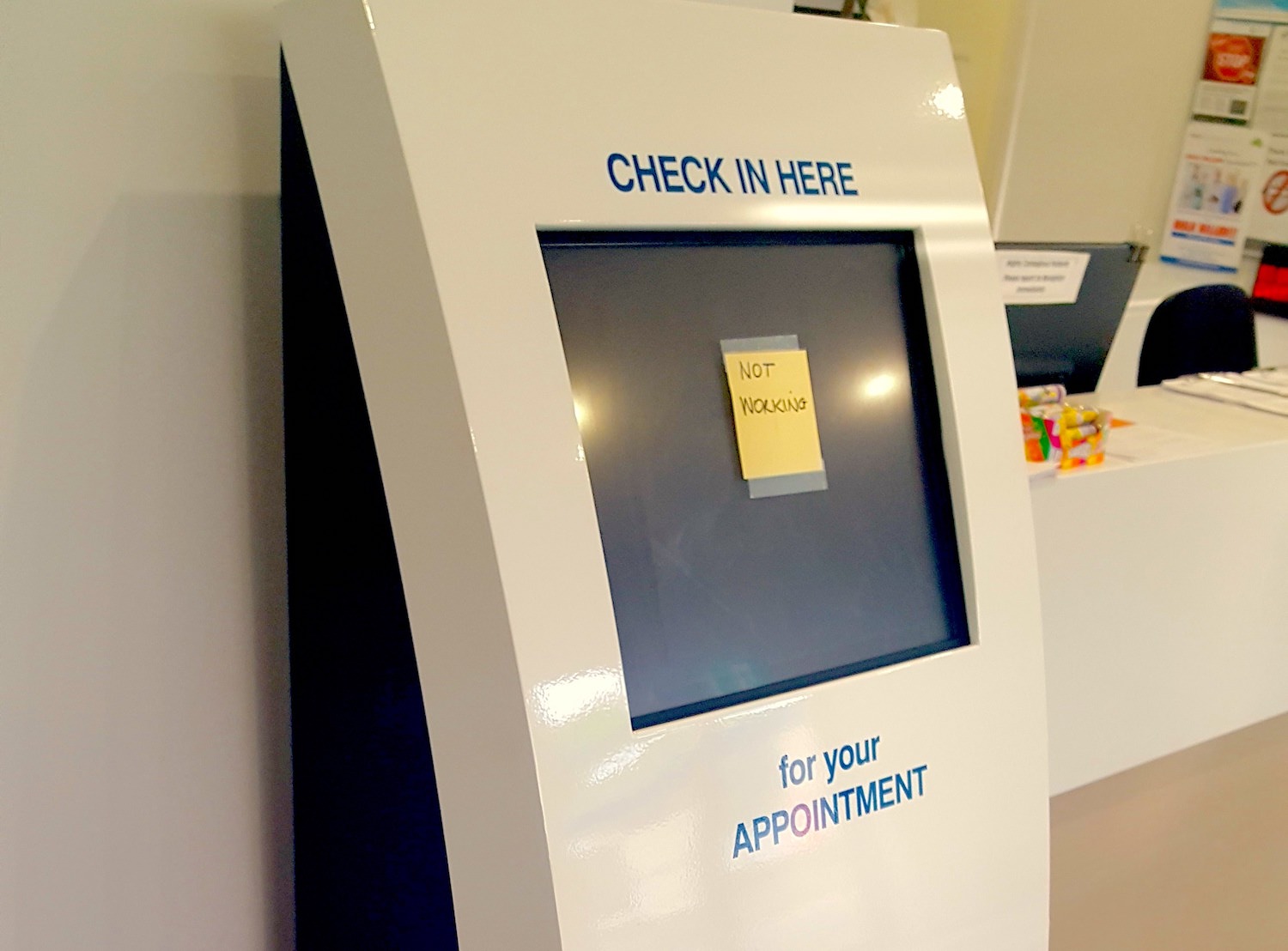Practices are always looking for ways to save their front desk staff time by increasing the efficiency of routine tasks. However, it can be easy to forget why we go to the lengths that we do to try and gain back hours, minutes and seconds in a day.
At HealthEngine, we believe that the main benefit of saving time is to improve patient outcomes, by turning the focus from administrative processes to providing the best care possible. This is true for every member of a practice’s staff: the front desk, the nurses, the practice manager, and of course, the practitioners themselves.
With that in mind, there are a number of reasons why we believe that check-in kiosks miss the mark when it comes to the benefits of saving time. So much so, that we even removed the check-in kiosk from our own office! Now when visitors step out of the elevator at HealthEngine HQ, the first thing they see is a warm, smiling face instead of an impersonal prompt on a flashing screen.
Check-in kiosks leave patients cold
When a practice installs a check-in kiosk they remove a warm, friendly interaction that would otherwise be a key part of building patient loyalty. Let’s think about this from the experience of the patient. The first thing that you want your patients to experience when they walk into your clinic is a welcoming smile from an engaged member of your front desk staff. A personal and caring greeting, not a cold and faceless experience.
When a practice installs a check-in kiosk they remove a warm, friendly interaction
Check-in kiosks are the impersonal equivalent of telling someone to take a number and join the queue. Without a personal welcome, you send your patients straight to the waiting room chair without asking how their holiday was, or asking after their grandchildren. You don’t get to advise them if the doctor is running late and that they have time to grab a coffee. You miss the chance to show them that you care about them as people.
And let’s not forget the hygiene factor. Do your patients really enjoy typing in their details on a screen that people with the flu, runny noses or bad coughs have likely just handled?
Check-in kiosks are expensive
The cost of installing a check-in kiosk for your practice can easily exceed $1,500, with the monthly subscription cost for the software often in the region of $1,200—$1,600 for an average sized GP practice.
A kiosk can’t cover other duties for a sick staff member, and a kiosk doesn’t remember to ask after a patient’s family
Whilst the cost of a check-in kiosk may approach the cost of a member of your front desk staff, the value, functionality and return on investment of installing a kiosk can never expect to compete with a human. A kiosk can’t cover other duties for a sick staff member, a kiosk doesn’t remember to ask after a patient’s family, and a kiosk definitely can’t placate an irate patient when the practitioner is running late.
When provided by a person, these details all contribute to giving patients a great experience in your practice.
Looking outwardly to other industries, kiosk technology is already going out of date. For example, some airlines are already moving to mobile app based check-in systems. It won’t be long until that costly kiosk is gathering dust in an unused corner of the practice.
Check-in kiosks treat the symptom, not the cause!
If phone calls are keeping your front desk occupied and preventing them from being able to efficiently check patients in, kiosk only treats the symptom of this, not the cause. When we analyse the most time consuming interactions for the front desk, we find that:
- taking bookings over the phone,
- chasing & rebooking Did Not Attend patients,
- taking payments after a consult, and,
- processing paper recalls
are all far more time consuming than checking in patients.
Reduce the time your staff have to be on the phone by offering online bookings, or save time by processing recalls via SMS and in-app notifications. That way your front desk staff are free to more fully give their care and attention to the patients in the waiting room.
In conclusion
It’s true that practices need to continually move with the times and embrace new technology. Whilst there’s a place for automation in a healthcare practice, it should only be to enhance the patient experience, never at the expense of it.
When they enter your practice, patients are already feeling unwell, harried or possibly anxious about undergoing tests or receiving results. A reassuring, personalised welcome can generate enormous patient loyalty, treating them with a level of service they’ll remember next time they’re booking an appointment.
You can’t automate warmth, care and human interaction!

